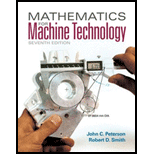
Concept explainers
(a)
The measurement of
Answer to Problem 7A
The measurement of
Explanation of Solution
Given information:
The below figure represent the Metric steel Rule.

Figure-(1)
Write the expression for the measurement by the enlarged fractional rule.
Here, the measurement by the enlarged fractional rule is
Here, the total measurement of scale nearest of
Calculation:
Substitute
Conclusion:
The measurement of
(b)
The measurement of
Answer to Problem 7A
The measurement of
Explanation of Solution
Given information:
Here, the total measurement of scale nearest of
Calculation:
Substitute
Conclusion:
The measurement of
(c)
The measurement of
Answer to Problem 7A
The measurement of
Explanation of Solution
Given information:
Here, the total measurement of scale nearest of
Calculation:
Substitute
Conclusion:
The measurement of
(d)
The measurement of
Answer to Problem 7A
The measurement of
Explanation of Solution
Given information:
Here, the total measurement of scale nearest of
Calculation:
Substitute
Conclusion:
The measurement of
(e)
The measurement of
Answer to Problem 7A
The measurement of
Explanation of Solution
Given information:
Here, the total measurement of scale nearest of
Calculation:
Substitute
Conclusion:
The measurement of
(f)
The measurement of
Answer to Problem 7A
The measurement of
Explanation of Solution
Given information:
Here, the total measurement of scale nearest of
Calculation:
Substitute
Conclusion:
The measurement of
(g)
The measurement of
Answer to Problem 7A
The measurement of
Explanation of Solution
Given information:
Here, the total measurement of scale nearest of
Calculation:
Substitute
Conclusion:
The measurement of
(h)
The measurement of h.
Answer to Problem 7A
The measurement of h is
Explanation of Solution
Given information:
Here, the total measurement of scale nearest of h is
Calculation:
Substitute
Conclusion:
The measurement of h is
(i)
The measurement of i.
Answer to Problem 7A
The measurement of i is
Explanation of Solution
Given information:
Write the expression of measurement of the enlarged decimal rule.
Here, the total measurement of scale nearest of
Calculation:
Substitute
Conclusion:
The measurement of i is
(j)
The measurement of
Answer to Problem 7A
The measurement of
Explanation of Solution
Given information:
Here, the total measurement of scale nearest of
Calculation:
Substitute
Conclusion:
The measurement of
(k)
The measurement of
Answer to Problem 7A
The measurement of
Explanation of Solution
Given information:
Here, the total measurement of scale nearest of k is
Calculation:
Substitute
Conclusion:
The measurement of
(l)
The measurement of l.
Answer to Problem 7A
The measurement of l is
Explanation of Solution
Given information:
Here, the total measurement of scale nearest of l is
Write the expression for the enlarged decimal rule.
Here, the total measurement is
Calculation:
Substitute
Conclusion:
The measurement of l is
(m)
The measurement of m.
Answer to Problem 7A
The measurement of m is
Explanation of Solution
Given information:
Here, the total measurement of scale nearest of m is
Calculation:
Substitute
Conclusion:
The measurement of m is
(n)
The measurement of n.
Answer to Problem 7A
The measurement of n is
Explanation of Solution
Given information:
Write the expression of measurement of the enlarged decimal rule.
Here, the total measurement is
Here, the fractional measurement of scale nearest of n is
Calculation:
Substitute
Conclusion:
The measurement of n is
(o)
The measurement of o.
Answer to Problem 7A
The measurement of o is
Explanation of Solution
Given information:
Here, the total measurement of scale nearest of m is
Calculation:
Substitute
Conclusion:
The measurement of o is
(o)
The measurement of p.
Answer to Problem 7A
The measurement of p is
Explanation of Solution
Given information:
Here, the total measurement of scale nearest of m is
Calculation:
Substitute
Conclusion:
The measurement of p is
Want to see more full solutions like this?
Chapter 28 Solutions
Mathematics for Machine Technology
- Decimal-Inch Steel Rules Read measurements a-d on the enlarged fractional rule shown Figure 30-16.arrow_forwardRead measurements on the enlarged fractional rule shown in Figure 30-12.arrow_forwardFive pieces are cut from the length of round stock shown in Figure 10-6. After the pieces are cut, the remaining length is thrown away. What decimal fraction of the original length of round stock (17 inches) is the length that is thrown away? All dimensions are in inches.arrow_forward
 Mathematics For Machine TechnologyAdvanced MathISBN:9781337798310Author:Peterson, John.Publisher:Cengage Learning,
Mathematics For Machine TechnologyAdvanced MathISBN:9781337798310Author:Peterson, John.Publisher:Cengage Learning,
